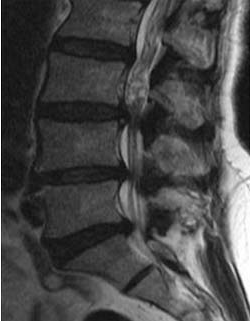Lumbar Microdecompression
- Home
- Lumbar Microdecompression
Lumbar Microdecompression
What is lumbar spinal canal stenosis?
The lumbar spinal canal is a central canal in the lower spine that carries nerves from the brain to your legs. Narrowing of this canal is called “lumbar spinal canal stenosis.”

Normally nerves have adequate space to travel through the spinal canal. In stenosis, there is a block in the canal due to bulging discs and buckled ligaments.
What are the causes of canal stenosis?
The most common cause of stenosis is degeneration (age related wear and tear) of the spine. Other rare causes include congenital (by birth), inflammatory and metabolic (example fluorosis).
How does degeneration cause the spinal canal to narrow?
As people age, the nucleus of the disc begins to “dry up,” reducing the effectiveness of the shock-absorbing quality of the discs. As this protection is lost, daily activities can stress the vertebrae, causing the development of bony spurs. Bone spurs can cause the centre canal that encases the spinal cord and the side canals, which protect the nerves, to become narrowed. In addition to the bony spurs the disc protrudes into the spinal canal further narrowing the canal.

MRI image shows a complete block of spinal nerves at many levels in spine
What are the symptoms of lumbar spinal canal stenosis?
NEUROGENIC CLAUDICATION – People with stenosis usually have leg pain most of the time. They may also have numbness or weakness of the legs. The leg pain and numbness usually starts when they stand up and begin to walk or exercise. The leg pain has been described as a burning or prickly feeling that may start in the buttocks and spread down to the feet when you start walking.
The legs might also feel cramped, tired or weak. These leg symptoms are a condition called neurogenic claudication of the legs. In lumbar canal stenosis, the neural leg claudication starts when you stand up, gets worse when you walk. The pain gets better when you sit or crouch down, it’s believed that this position “opens” the lumbar canal and takes the pressure off the nerves that go to the legs.
Why do I get leg pain in lumbar canal stenosis?
The narrowing of the spinal canal or the side canals that protect the nerves often results in a pinching of the nerve roots of the spinal cord, this gives rise to leg pain, numbness and or weakness of the legs. The nerves become increasingly irritated as the diameter of the canal becomes narrower.
Investigations:
The diagnosis of lumbar canal stenosis is based on a thorough clinical exam and medical history. Radiographic tests might be helpful in confirming a diagnosis. X-ray: of the lumbar spine may show degenerative changes of the spine and narrowing of the canal for the nerves.
Magnetic resonance imaging (MRI): is the investigation of choice as it clearly delineates the narrowing of the spinal cord, exact level and cause of nerve compression. This helps in planning the further course of treatment. In case, surgery is required the MRI aids in pre-operative planning.

MRI in lumbar canal stenosis
Nerve conduction studies: In patients with co existing neuropathies or atypical symptoms the diagnosis of canal stenosis is not straight forward. In these patients the diagnosis may have to be confirmed by doing nerve conduction tests.
How is lumbar canal stenosis treated?
Lumbar canal stenosis can be treated non-operatively in most patients; however in severe symptomatic stenosis, surgery may be required.
Anti-inflammatory’s and analgesics to reduce swelling and relieve pain.
Physical therapy and/or prescribed exercises may help stabilize your spine, build your endurance, and increase your flexibility. Therapy may help you resume your normal lifestyle and activities.
Epidural injections of cortisone may be prescribed to help reduce swelling. This treatment is not recommended repeatedly and usually provides only temporary pain relief.
Surgery is required if conservative treatment options, such as physical therapy and medications do not reduce or end the pain altogether. Patients who have one or more of the following symptoms may require surgery.
- Back and leg pain that limits normal activity or impairs your quality of life.
- Progressive neurological deficits, such as leg weakness and/or numbness.
- Loss of normal bowel and bladder functions.
There are several different surgical procedures which can be utilized, the choice of which is influenced by the severity of your case. In a small percentage of patients, spinal instability may require that spinal fusion be performed, a decision that is generally determined prior to surgery. Spinal fusion is an operation that creates a solid union between two or more vertebrae. This procedure may assist in strengthening and stabilizing the spine and may thereby help to alleviate severe and chronic back pain.
What are the surgeries performed for lumbar spinal canal stenosis?
Limited internal decompression- This is a micro surgery where through a small incision pressure on compressed nerves is relieved without causing collateral damage to the normal spinal structures.
Decompressive laminectomy: In this surgery the lamina (roof) of the vertebrae is removed to create more space for the nerves. This is a more extensive surgery than the limited internal decompression.
Decompression, Posterior instrumentation and fusion – during decompression the pressure and compression of the nerves is relieved. Fusion means joining of two vertebrae to become a single unit. Instrumentation (stabilization) is the use of metal plates, screws and rods to hold the vertebrae in position till they fuse. Fusion is achieved by placing bone graft over the back of the vertebrae. This procedure is performed only in patients with significant instability or back pain.
Decompression and Lumbar Inter-body Fusion (PLIF/TLIF) – In some patients, additional stabilization of the spine is required. So in addition to decompression, posterior instrumentation and fusion, metal cages are placed in between the vertebral bodies to achieve a solid fusion.
Our institution performs many surgeries for lumbar canal stenosis every year. We focus on a refined approach to patients using advanced imaging techniques combined with thorough clinical examination to identify the source of the problem. Micro-surgery is used in all possible cases to minimize the surgical damage to normal tissues. This combines to make surgery successful with minimal pain and prevents long term surgical complications.
Surgical Expertise
Testimonials
What Our Patients Say
EXCELLENT rating
Based on 107 reviews My father had rotator cuff problems and needed follow-up care.Dr.Ankith N V was exceptional. They provided thorough, compassionate care and clear communication. The clinic was well-equipped, and attentive Highly recommend.
My father had rotator cuff problems and needed follow-up care.Dr.Ankith N V was exceptional. They provided thorough, compassionate care and clear communication. The clinic was well-equipped, and attentive Highly recommend. RAVINDRA KUMAR2024-06-09Very good Orthopaedic Clinic and Dr Ankith sir well experienced Dr and also clear all the doubts for patients and their families...
RAVINDRA KUMAR2024-06-09Very good Orthopaedic Clinic and Dr Ankith sir well experienced Dr and also clear all the doubts for patients and their families... Dilip Gowda BR2024-05-29I had an outstanding experience with Dr. Ankit at Ankit’s Orthopedic . Dr. Ankit’s exceptional friendliness and professionalism made me feel comfortable and well-cared for throughout my visit. I highly recommend Dr. Ankit for their exemplary patient care and welcoming demeanor.
Dilip Gowda BR2024-05-29I had an outstanding experience with Dr. Ankit at Ankit’s Orthopedic . Dr. Ankit’s exceptional friendliness and professionalism made me feel comfortable and well-cared for throughout my visit. I highly recommend Dr. Ankit for their exemplary patient care and welcoming demeanor. Nikhil L2024-05-29Doctor is so knowledgeable and humble. Also he listens to us keenly and understands the problem. Highly recommended.
Nikhil L2024-05-29Doctor is so knowledgeable and humble. Also he listens to us keenly and understands the problem. Highly recommended. Akshay2024-05-29Good communicate with patients and cooperation well good, we are satisfied your treatment.
Akshay2024-05-29Good communicate with patients and cooperation well good, we are satisfied your treatment. renuka Mallikarjuna2024-05-22Best orthopaedic clinic in vijayanagar good service
renuka Mallikarjuna2024-05-22Best orthopaedic clinic in vijayanagar good service ಬಳ್ಳಾರಿ ನಾಗ2024-05-22Very good doctor and
ಬಳ್ಳಾರಿ ನಾಗ2024-05-22Very good doctor and Kiran S2024-05-18Really...this clinic is too good i recommended Dr.Ankith sir ..and doctor treat very well, he had more knowledge and as well as good human being and his staff is wonderful, this is the perfect place for orthopedic and spine
Kiran S2024-05-18Really...this clinic is too good i recommended Dr.Ankith sir ..and doctor treat very well, he had more knowledge and as well as good human being and his staff is wonderful, this is the perfect place for orthopedic and spine ashoka vc2024-05-17Good service well qualified doctor
ashoka vc2024-05-17Good service well qualified doctor srinath v2024-05-17
srinath v2024-05-17
Book Your Appointment Today!
Call us at 099644 83761 to schedule your visit. Your path to recovery begins at Dr. Ankith’s Orthopedic & Spine Care Clinic. We look forward to helping you achieve your health goals!
